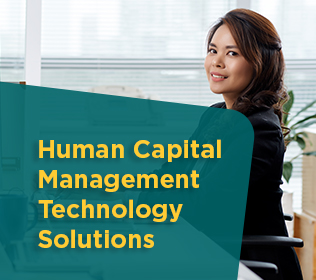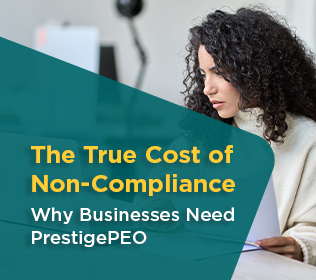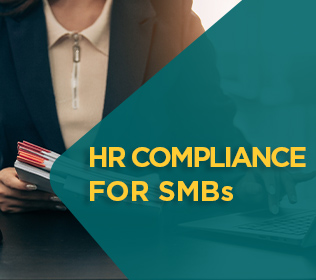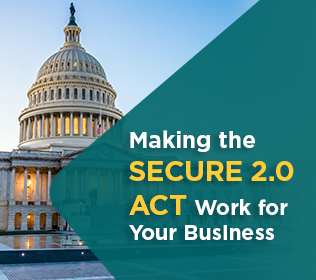
The business landscape is rapidly evolving, and technology is constantly advancing. Staying ahead in human resources requires embracing cutting-edge technologies, especially for small and medium-sized businesses (SMBs). In this digital transformation era, also known as the “Age of AI,” where efficiency counts, Artificial intelligence (AI) in HR has emerged as a game-changer in reshaping HR practices. In fact, AI has become necessary for SMBs striving to compete in today’s dynamic marketplace.
Artificial intelligence in HR offers viable solutions that are tailored to the unique needs of smaller businesses, as it provides cost-effective alternatives to traditional HR methods. In this blog, we’ll explore three innovative AI tools and trends that are reshaping HR practices, specifically for SMBs. Learn why employers should be embracing AI for HR to handle things like employee onboarding, team engagement, and performance management. Let’s discover how artificial intelligence can help businesses improve their HR efficiencies.

1. AI-Powered Solutions: Improving HR Efficiency in the Employee Onboarding Process
Employee onboarding is a cumbersome task. And outside of the interview process, it’s the first interaction a new employee has with a company, shaping their first impressions of your organization. There are many steps that must be performed when you onboard a new employee. You’ll need to train the employee on their job tasks and office information as well as collect and file paperwork with Personal Identifiable Information (PII). When a business reaches a point in its growth where there is a consistent flow of newly hired employees to train, it quickly becomes necessary to hire an entire team of people to perform these tasks.
Given these challenges, it becomes clear that leveraging AI tools and automation can significantly improve the onboarding process. Artificial intelligence can facilitate a more streamlined paperwork process and faster integration of these new hires into your company’s work structure. With AI-powered solutions, your new employees are automatically taken through each step in the process. This includes entering contact information, picking their employee benefits, and even uploading their banking providers.
Then, once the employee is onboarded, AI can help with training on their specific job and general service skills. Additionally, HR technology can be used to provide background information on the company and any education that is necessary for the employee to perform their job. Artificial intelligence in the workplace can assist in the employee’s development and education to ensure they are prepared to perform at their best, which leads to better retention and team satisfaction. Let’s dive deeper into how AI tools can assist in the employee onboarding process.
The Power of Virtual Employee Onboarding AI Tools
When arriving on their first day, an employee can become overwhelmed with meeting new people, getting used to a new office environment, and what their responsibilities will be. While it might be difficult for a hiring manager or an HR representative to communicate all that the new hire needs to know, they can rely on AI for HR training solutions for assistance.
These AI-powered solutions can be loaded with company information, including office culture, organizational charts, history, and more. While going through these modules, some companies can choose to set up a chatbot function. This way, if employees have questions or concerns as they are completing their modules, they can ask the HR tool for answers.
Employers can also use these AI tools for onboarding paperwork. Step-by-step instructions can provide detailed guidance for employees to manage their required forms. This will help speed up the process and eliminate the need for a member of staff to take time out of their day to go through each piece. Empowering employees to accomplish and learn in their first few weeks creates a positive experience for everyone and makes for a favorable first impression of their new company. Plus, this foundational information of the company is crucial in an employee having the knowledge they need to succeed.
Artificial Intelligence Tools for Personalized Training in HR
AI has modernized HR training assistance by offering businesses personalized recommendations tailored to the individual needs of their employees. Adaptive learning platforms leverage AI processes to understand the unique learning styles and preferences of each employee. The more an employee or business owner interacts with the platform, the better the AI tool becomes.
These platforms can automatically change the learning modules and the pace of training based on employee feedback and engagement. This provides a personalized and effective learning experience. These AI insights can also evaluate the areas where employees may need additional education. Surveys and quizzes to judge employees’ knowledge are built within the AI tool and are a great help as well. Organizations can use the data they garner to implement targeted learning initiatives and enhance overall workforce proficiency.
How AI Can Help with Employee Development Strategies and Programs
A business owner can create an employee-first atmosphere by using virtual onboarding assistance and personalized training recommendations. An encouraging environment where employees are allowed to learn and grow is a mark of an organization that recognizes the value of investing in their workforce. AI tools in the workplace serve the purpose of strategically fostering employee development. Companies can create a complete onboarding and training program by embracing these digital enhancements. This expedites the integration of new hires into the organization and adds to the ongoing growth and adaptability of current employees in an ever-evolving business landscape.

2. AI For HR: How Artificial Intelligence Can Increase Employee Engagement and Retention Success
Employee engagement and retention monitoring is the biggest money-saving tactic for small and medium-sized businesses. According to SHRM, the estimated cost of replacing an employee is three to four times the position’s salary. Business owners lose precious time not only searching for a new candidate but also allowing the employee to overcome the natural learning curve as they adjust to their new role. By fostering a healthy and productive work environment, owners can proactively address potential issues within the workforce. But how does a busy manager coordinate efforts to check in with their entire staff? It is often impossible with the ongoing list of business tasks. That’s why organizations are increasingly turning to predictive analytics with their HR technology for turnover risk.
By leveraging advanced data analysis and AI tools, businesses can identify patterns and trends that may indicate employees at a higher risk of leaving. This proactive approach allows HR professionals or the expert team with a business’s PEO partner to intervene early, offering targeted support and implementing strategies to mitigate turnover risks.
AI and Predicative Analytics: Assessing Employee Turnover Risks and Challenges
Proactively understanding an unhappy employee can be key to turning things around, re-engaging, and retaining them. Powerful AI insights can monitor key indicators like decreased productivity, increased absenteeism, or changes in communication patterns. Think about the behavior of an employee right before they quit. Were you concerned about their shift in demeanor? Or maybe you didn’t realize it until after they submitted their notice? By utilizing data-driven approaches, organizations can identify areas of concern and take prompt action to reinvigorate employees.
These AI-powered analytics tools analyze employee data to identify patterns. This works by utilizing the historical data on file and comparing it to how the employee is acting in the present. A good example of concerning employee behavior is increased days off. A predictive tool can look at the amount of PTO days taken which will help managers know when to check in with their employees and feel out their work situation.
Additionally, a current skill analysis or survey to help an employee understand where they are lacking may provide insight into where they may be eligible for educational classes. By offering the opportunity to learn, the organization allows an employee to move up the ladder and gives them the incentive for better production. If the employee is interested and excited to take on these opportunities, it is a good indicator of employee satisfaction, because if they cannot get the training they need in their current position, they may look elsewhere to fulfill their personal and career goals.
This qualitative data can be complex to dissect, which is why artificial intelligence in the workplace allows for ease of use. Looking at a group of employees from a bigger-picture perspective may give different data to predict turnover as well. There are AI tools that can look at different job roles, departments, seniority levels, and the number of years those people have been with the company.
Using this data rich information, the tool can predict which combination of those employee attributes are most likely to leave and when. For example, looking at roles that have a high turnover rate may be a great indicator of where things should shift. An employee in the sales department who has been with the company for 2 years without gaining a management role may be at risk of quitting. As a business owner, you might know this because it is a regular pattern you continue to see. This sort of AI insight can give managers information about which roles are high risk and potentially provide new hires with what they need to be successful and long-term within the same position.
By analyzing historical employee data, AI algorithms can predict which employees are most likely to leave the organization, allowing HR teams and managers to intervene and take necessary steps to retain them. This predictive capability of AI enables companies to be proactive rather than reactive in their retention efforts.
Important elements to remember when selecting a PEO include personalized customer service, adherence to compliance regulations, and transparent pricing. PEOs provide substantial assistance to small and medium-sized businesses. However, it’s crucial to thoroughly evaluate your options to choose the PEO that best aligns with your business needs. PrestigePEO has the experience, certifications, and compassion to cater to your HR needs with care. Contact us today to learn more about how we can help.

3. Utilizing AI Insights to Develop Stronger Performance Management Strategies
Performance management is crucial for small and medium-sized business owners to accomplish at least annually to retain their great employees. Yearly reviews and regular goal-checking are overwhelming but essential if you want to manage and use continuous feedback from your employees to improve your company. Performance systems can play a pivotal role in enhancing employee development, and leveraging AI-powered feedback tools enables organizations to gain real-time insights into employee performance.
Make sure that your employees know that you recognize how much they have achieved. Similarly, make sure employees know where you’d like them to focus for growth and improvement. This shows great concern for their career growth and makes employees feel valued. Employees always want feedback, whether positive or negative, because it allows for the appreciation they deserve and the changes they need to make.
How AI Tools Can Help with Objective Performance Management
When performing reviews, it’s important to consider what steps to put in place to keep these reviews objective and unbiased. Objective performance measurement can be implemented by data-driven metrics, which provide a transparent and fair evaluation of employees. By utilizing measurable data, organizations can assess the impact of individual efforts on the business’s goals. Goal setting and progress tracking, which can also be supported by an AI tool, will create a structure for employees to align their efforts with the company’s intentions. Combined, this approach enhances individual performance and creates a sense of purpose with alignment to organizational goals for overall success.
AI in HR Trends: Preparing for the Future Workforce Landscape
Artificial intelligence in the workplace, specifically within HR efforts, creates overall accountability for both the employee and the employer. The integration of these tools within HR can help to change an employee’s experience for the better. AI-powered solutions have redefined employee onboarding, streamlined processes, and personalized the development of new hires. With AI-enhanced engagement strategies, a small business owner can better connect to their staff and improve their workplace culture. As AI for HR continues to evolve, its role will further improve the overall employee day-to-day experience, contributing to more agile, productive, and engaged workforces.
PEOs Help SMBs Thrive with Expert Professional Guidance
While artificial intelligence in the workplace can be intimidating, automated platforms are useful and affordable compared to trying to hire an entire team of people. The ability to manage tasks like onboarding, performance management, training, and more through a system that does not need to be operated by an HR person is incredible. Similarly, partnering with a PEO gives you access to an entire HR team without having to hire additional team members in-house. AI tools can help complement your business needs, and so can PEO services. If you’re interested in learning about how AI tools can support your business efforts, as well as additional HR support, a PEO is something to consider.
Contact PrestigePEO to learn more about how PEO services can take your business to the next level.




